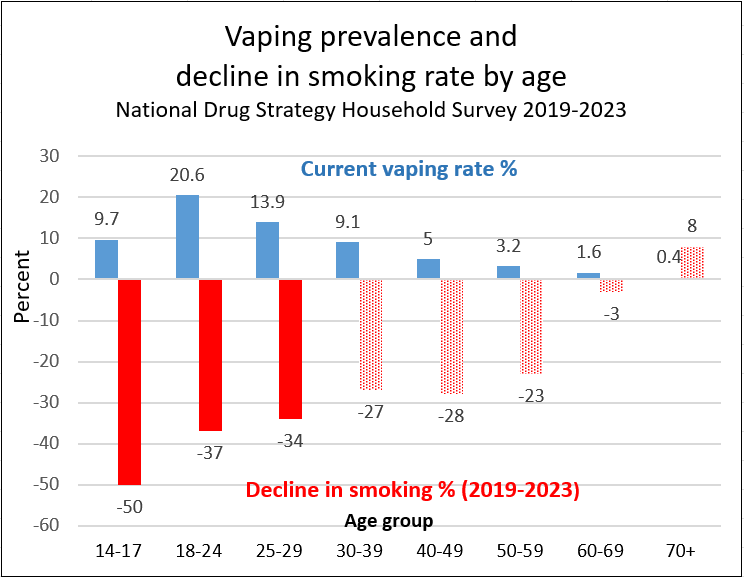
Latest national survey: smoking down and vaping up
Posted on February 29, 2024 By Colin
AFTER YEARS OF STAGNATION, the latest National Drug Strategy Household Survey has reported an accelerated decline in adult daily smoking, from 11% in 2019 to 8.3% in 2022/23. This 25% decline in smoking (6% per year) is twice as fast as in the previous 9 years (3% per year).
The more rapid fall in smoking reflects the rise in adult daily vaping which tripled from 1.1% in 2019 to 3.5% in 2023.

Vaping is almost certainly the main cause of this faster decline in smoking. There were no other significant changes in tobacco control in Australia during the survey period
This is a huge step forward in combatting the leading preventable cause of death and illness in Australia.
The changes mirror the remarkable decline in smoking in New Zealand as vaping rates increased. After daily vaping increased above 3.5% in New Zealand in 2020, the daily smoking rate plummeted and is now 6.8%.

Vaping was by far the most popular quitting aid reported by Australian smokers, used in 32% of attempts to quit or reduce smoking, and was twice as popular as nicotine patches and gum (17%). Vaping is also the most effective quitting aid.
The combination of vapes being both popular and effective explains why they have more impact on smoking rates than any other intervention
Vaping was most common in the 14-29 year age group. Not surprisingly, the highest smoking quit rates were also in this younger population as shown in other research. Vaping was rare in the over 60s and the smoking rate did not decline significantly in this population. More education and vaping support should also be provided to older smokers.

Youth smoking and vaping
Despite claims by the Health Minister and his advisers, the uptick in youth vaping has not led to increased smoking by youth (14-17-year-olds). In fact, daily youth smoking fell by 53% from 1.9% in 2019 to 0.9% in 2023 (10,000 daily vapers). The numbers in 2023 were so small, they could not be guaranteed as accurate.
This is at odds with the Health Minister's repeated false claim that "Tragically, the only cohort in our community where cigarette smoking is on the rise is the youngest members of our community."
The data provide further evidence that, rather than being a gateway to smoking for youth, vaping is more likely diverting youth away from smoking
Young non-smokers should not smoke or vape, but these figures represent a massive public health win overall. Most vaping by young never-smokers is experimental and short-term and carries relatively minor health risks.
However, for young people who vape instead of smoke, there are huge health benefits which far outweigh the small risk to the occasional recreational user.
Is prohibition working?
The adult vaping rate has risen significantly despite the de facto prohibition imposed by the Health Minister. A total of 1.5 million adults now vape.
Australians have rejected the Health Minister’s interference and attempt to control vapes as medical devices. Eighty seven percent of vapers reported not having a prescription and vaping illegally.
The outcomes for public health could be so much better if the Australian health system actually supported and encouraged smokers to switch to the far safer alternative, instead of actively trying to stop them
Reference
The NDSHS is a triennial survey of legal and illicit drug use by the Australian Institute of Health and Welfare. The latest survey was carried out during 2022 and 2023 and involved over 21,000 Australians 14 years and older.
Expert reaction from the Australian Science Media Centre. 29 February 2024
Go to Top